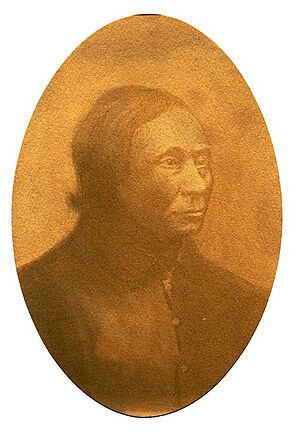Leschi (Nisqually) facts for kids
Quick facts for kids
Leschi
|
|
|---|---|

Chief Leschi
|
|
| Nisqually leader | |
| Personal details | |
| Born | 1808 near present day Eatonville, Washington |
| Died | February 19, 1858 (aged 49-50) Lake Steilacoom, present-day Lakewood, Washington 47°10′43″N 122°32′31″W / 47.178575°N 122.542065°W |
| Cause of death | Execution by hanging |
| Resting place | Puyallup Tribal Cemetery – Tacoma, Washington 47°14′19″N 122°23′56″W / 47.2386°N 122.3989°W |
Chief Leschi (born 1808 – died February 19, 1858) was an important leader of the Nisqually Indian Tribe. This tribe lived in the southern Puget Sound area of Washington. Their main home was near the Nisqually River.
Leschi became a leader during a time of conflict. There were outbreaks of violence and wars, like the Yakima War (1855–1858). He was accused of killing two Washington Territorial Volunteers. On February 19, 1858, he was executed. However, many people believed he was innocent. They argued that he could not be charged with murder because the deaths happened during a war.
In 2004, a special Historical Court of Inquiry in Washington State reviewed his case. They decided that Leschi was wrongly convicted. This decision was not legally binding, but it showed that history now views him differently.
Who Was Chief Leschi?
Leschi was born in 1808. His family belonged to the Mishalpam band of the Nisqually tribe. His father was a Nisqually chief, and his mother was from the Klickitat tribe. Their main village was called Basha'labsh. It was located on the Mashel River near what is now La Grande, Washington.
Leschi had an older brother named Quiemuth and a sister. The Nisqually people lived in a large area along the Nisqually River. This area was full of fish and game, especially salmon, which was a very important food source for them. Leschi was a respected leader among his people. The meaning of his name is not fully known.
The Treaty of Medicine Creek
In 1854, Isaac Stevens was the first governor of Washington Territory. He chose Leschi to represent the Nisqually and Puyallup tribes. This was for a meeting called the Treaty of Medicine Creek council. It took place on December 26, 1854.
At this meeting, the tribes were pressured to give up their land to the United States. This land included parts of what are now King, Pierce, Lewis, Grays Harbor, Mason, and Thurston counties. The agreement also said that the Native American people living there had to move to special areas called reservations.
Some historians believe Leschi refused to sign the treaty. They say his "X" mark might have been faked by someone else. Other stories say he signed it but only because he had to. He strongly argued that the land chosen for the Nisqually reservation was not good. It was rocky and high up, making it hard to grow food. It was also cut off from the Nisqually River, which was vital for their salmon fishing.
His Legacy
Chief Leschi's name lives on in many places. In the late 1880s, a man named Frederick J. Grant named the Leschi neighborhood in Seattle after him.
Other places also honor Chief Leschi:
- Leschi Park in Seattle.
- Schools in Seattle and Puyallup.
- Streets in Seattle, Lakewood, Steilacoom, Anderson Island, and Olympia.
- A training site at Joint Base Lewis-McChord is called Leschi Town.
- A fireboat for the Seattle Fire Department, named Leschi, also carries his name.
His Exoneration
In March 2004, lawmakers in Washington state made a special decision. Both parts of the state legislature passed resolutions. These resolutions said that Leschi was wrongly convicted and executed. They asked the state's highest court to officially cancel his conviction.
However, the chief justice of the court said this was unlikely. It was not clear if the state court had the power to change a decision made 146 years earlier by a different court.
On December 10, 2004, Chief Leschi was cleared of the charges. A Historical Court of Inquiry held a special trial for him, even though he was not there. They voted unanimously that he was innocent. This decision was not legally binding, but it was an important step in recognizing his story.
See also
 In Spanish: Jefe Leschi para niños
In Spanish: Jefe Leschi para niños


